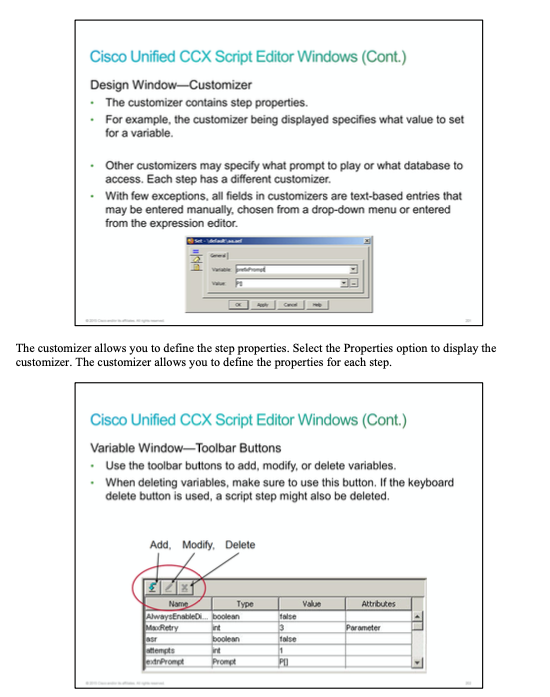Deploying Cisco Unified Contact Center Express (UCCXD)
Cisco Unified CCX
- Relationship between the Unified CCX platform and the three products it supports
- Three Cisco products supported by the Unified CCX engine platform
- Unified CCX hardware and software components to include all server types, standby deployments, and scalability
- New and improved functions of the three Unified CCX products to include Unified CCX v11.0
- Properly size the Unified CCX products by using calculators provided by Cisco
- Properly order Unified CCX products using the Unified CCX configuration and ordering tool
- Network considerations surrounding a Unified CCX deployment
- Using the Solution Reference Network Design for Cisco Unified CCX and Cisco Unified IP IVR and other documents to support a Unified CCX design and deployment
- Installing Unified CCX software on all servers in a cluster
- Activating and configuring all components in a CCX cluster
- Configuring and testing a simple CCX Script Application
- Troubleshooting installations using log files4. Unified CCX Editor
- Navigate the Unified CCX Editor functionality
- Creating, deleting, and editing variables
- Saving and uploading valid scripts to the repository
- Performing the debug process to test a script
- Troubleshooting an application and script using trace files Basic Unified CCX Editor Steps
- Creating a simple script workflow to answer a call
- Adding comments to identify and explain the script and subsequent groups of steps
- Playing voice prompts to share information or instructions with callers
- Terminating and ending a call• Validate, save as, upload, refresh, and debug a script
- Collecting information from a caller by presenting a list of choices using the menu step
- Collecting digits from a caller by using the Get Digit String step
- Getting information from the system to alter the logic of the call flow
- Validate, save as, upload, refresh, and debug the script
- Connecting to a database
- Reading and getting information from the database by creating a SQL query within a script step
- Referencing database locations
- Writing information to a SQL database
- Closing the database connection and terminating database resources
- Applying Boolean logic in scripts
- Creating and modifying counters
- Creating and managing timing loops
- Redirecting script logic based on the evaluation of “If” statements
- Using call subflows as reusable scripts
Başvurunuz kayıt numarası ile alınmıştır.
Talep Formu
| Adınız ve Soyadınız | |
| E-Posta Adresiniz | |
| Telefon Numarası | |
| Çalıştığınız Yer | |
| Okuduğunuz Okul | |
| Mesajınız |
Aktarılıyor...Dosya hazırlanıyor

